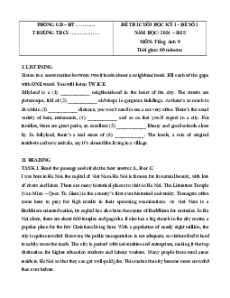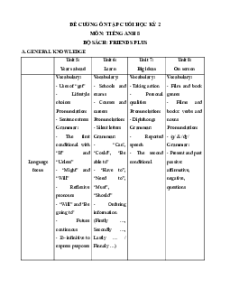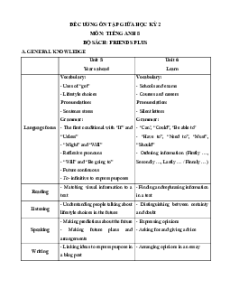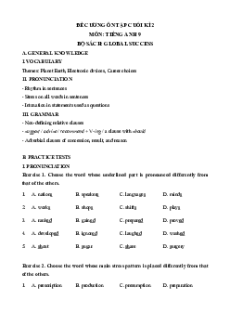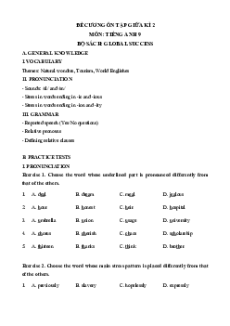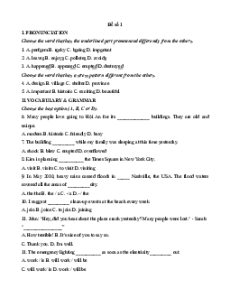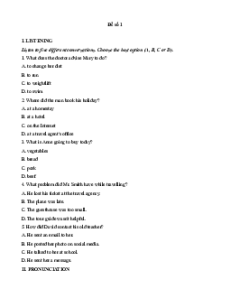PHÒNG GD – ĐT …………
ĐỀ THI CUỐI HỌC KỲ 1 - ĐỀ SỐ 5
TRƯỜNG THCS ………………
NĂM HỌC: 2024 – 2025 MÔN: Tiếng Anh 9 Thời gian: 60 minutes I. LISTENING
Listen to two teenagers calling the helpline. Circle the best answer A, B or C. You will listen TWICE.
1. Lan is now feeling ______. A. annoyed B. frustrated C. depressed
2. Lan can’t ______ all the deadlines. A. remember B. catch up with C. finish
3. Lan feels she doesn’t need to work too hard because she’s not going ______. A. to enter gifted schools B. to continue her study C. to have time for herself 4. Nam feels ______. A. tired of his study
B. worried about his girlfriend C. depressed
5. Nam’s friend _____________ in front of other students. A. made use of him B. made fun of him C. made joke about him II. READING
TASK 1. Read the following passage and circle the letter A, B, C, or D to indicate the
correct answer to each of the questions
Urbanisation occurs in many parts of the world, both in developed and developing nations. It
refers to the process in which urban areas grow as people leave the countryside or more
factories and towns are built in rural areas. This can lead to the concentration of populations
into towns and cities. When properly planned, urbanisation can bring a number of benefits,
especially for the economy and society. However, if it is poorly managed, it can pose a
significant challenge to maintaining the sustainability of these areas.
Big cities attract a lot of people as they usually offer more employment opportunities as well as
a better life. The economy of urban areas tends to grow rapidly as more businesses and
factories are created, and more workers are needed. Economic growth also leads to an increase
in household income and spending. This also encourages governments to spend money on
better schools, hospitals, roads, public transport, and more. As cities expand, many more
facilities such as public parks and gardens, swimming pools, libraries, cinemas, and sports
centres are built. These are just some of the spaces that make city life exciting and appealing to people of all ages.
However, when too many people move to a big city, without good planning and investment, its
infrastructure can become ineffective. For example, big urban areas can easily get overcrowded
as railway networks and roads can't cope with the large number of passengers. The economic
growth and expansion of big cities come at a big price for local residents as house prices and
rents go up, and they can't afford to either buy or rent. Another problem is that big cities are
experiencing more air pollution than rural areas. This can increase the risk of infections, heart
disease, and lung cancer, and severely affect people who are ill.
Urbanisation is a process that cannot be stopped and the best way to minimise the problems
caused by it is to plan for the growth and all the resources needed, and make sure the
infrastructure can support the increasing population.
1. Which of the following can be the best title for the passage? A. Urbanisation history B. Causes of urbanisation
C. The rapid speed of urbanisation
D. Positive and negative effects of urbanisation
2. The word “concentration” in paragraph 1 is closest in meaning to ______. A. emphasis B. gathering C. attention D. worry
3. According to paragraph 2, which of the following is NOT a reason why people move to big cities? A. Higher earnings. B. Government spending. C. More job opportunities.
D. A wide range of modern services.
4. The word “appealing” in paragraph 2 is closest in meaning to ______. A. attractive B. demanding C. exciting D. glamorous
5. The phrase “come at a big price” in paragraph 3 mostly means ______.
A. have an unpleasant consequence B. make big cities expensive
C. give local residents a lot of money
D. have something positive as a result
6. The word “they” in paragraph 3 refers to ______. A. big cities B. passengers C. house prices D. local residents
7. Which of the following can be inferred from the passage?
A. Economic growth can help minimise the problems of urbanisation.
B. Governments need to modernise city facilities.
C. Good urban planning is needed to manage rapid urbanisation.
D. Urbanisation only affects rural areas.
TASK 2. Choose the word or phrase among A, B, C or D that best fits the blank space in the following passage.
City planners have claimed trees (1)…… an important role in an urban environment. Children
(2)……. close to nature have better health, while walking in parks helps reduce blood pressure,
stress and obesity. The problem is to select the right trees and (3)…… them.
Ha Noi is considered one of the greenest cities in Viet Nam thanks to its beautiful and precious
trees. Ancient trees in Ha Noi are frequently (4)……. in poems. Each street can be (5)………
by a tree. To local residents, the hundred-year old trees that line the streets are more than just
beautiful, they are part of the city's identity. 1. A. act B. play C. enjoy D. perform 2. A. grow up B. grown up C. growing up D. being grown up 3. A. maintain B. service C. provide D. care 4. A. referred B. indicated C. spoken D. mentioned 5. A. described B. presented C. expressed D. explained III. WRITING
Circle the letter A, B, C, or D to indicate the sentence that is closest in meaning to each of the following questions.
1. The new employee completed the training programme, and now she is ready to start her new job.
A. After completing the training programme, the new employee is now ready to start her new job.
B. The new employee completed the training programme, which prepared her for her new job.
C. The new employee had finished the training programme, SO she can now start her new job.
D. Before the new employee completed the training programme, she was ready to start her new job.
2. The manager gave the team some words of encouragement before the big presentation, but they still felt nervous.
A. Despite the manager's words of encouragement, the team still felt nervous for the big presentation.
B. The team received some words of encouragement from the manager, so they felt nervous before the big presentation.
C. Although the manager gave the team some words of encouragement, they were still nervous before the big presentation.
D. Before the big presentation, the manager gave the team some words of encouragement, SO
that the team remained nervous.
3. The company hired a new CEO, and she implemented a new strategy to boost profits.
A. The new CEO were hired by the company, but she didn't implement a new strategy to boost profits.
B. After hiring, the new CEO of the company implemented a new strategy to boost profits.
Đề thi Cuối kì 1 Tiếng Anh 9 Global success (Đề 5 kèm file nghe)
1 K
521 lượt tải
MUA NGAY ĐỂ XEM TOÀN BỘ TÀI LIỆU
CÁCH MUA:
- B1: Gửi phí vào TK:
1133836868- CT TNHH DAU TU VA DV GD VIETJACK - Ngân hàng MB (QR) - B2: Nhắn tin tới Zalo VietJack Official ( nhấn vào đây ) để xác nhận thanh toán và tải tài liệu - giáo án
Liên hệ ngay Hotline hỗ trợ: 084 283 45 85
Chúng tôi đảm bảo đủ số lượng đề đã cam kết hoặc có thể nhiều hơn, tất cả có BẢN WORD, LỜI GIẢI CHI TIẾT và tải về dễ dàng.
Để tải tài liệu gốc về máy bạn click vào nút Tải Xuống ở trên!
Thuộc bộ (mua theo bộ để tiết kiệm hơn):
- Tailieugiaovien.com.vn giới thiệu bộ đề thi Cuối kì 1 Tiếng anh 9 Global success (kèm file nghe) mới nhất nhằm giúp Giáo viên có thêm tài liệu tham khảo ra đề thi Tiếng anh lớp 9.
- File word có lời giải chi tiết 100%.
- Mua trọn bộ sẽ tiết kiệm hơn tải lẻ 50%.
Đánh giá
4.6 / 5(1041 )5
4
3
2
1
Trọng Bình
Tài liệu hay
Giúp ích cho tôi rất nhiều
Duy Trần
Tài liệu chuẩn
Rất thích tài liệu bên VJ soạn (bám sát chương trình dạy)










